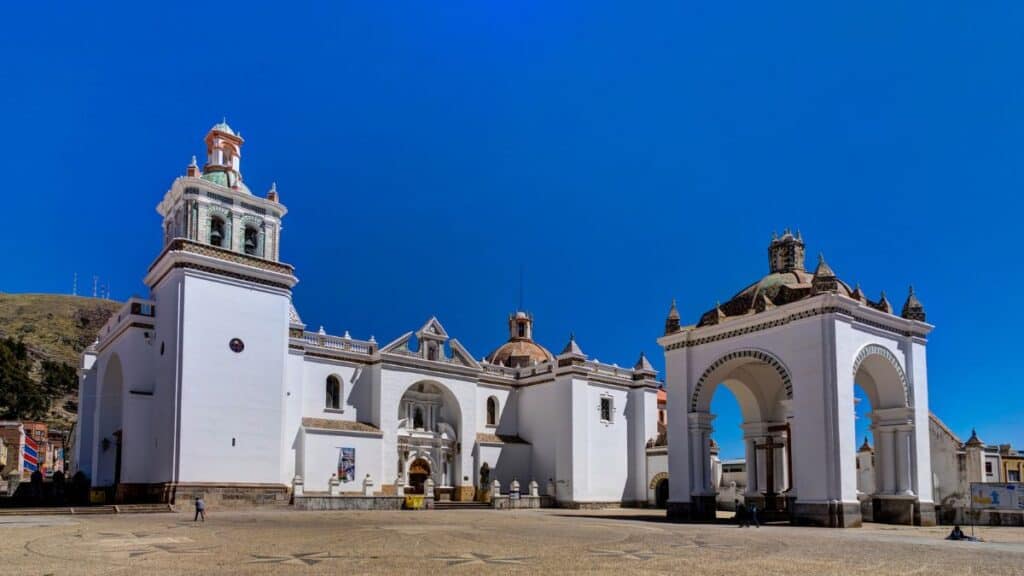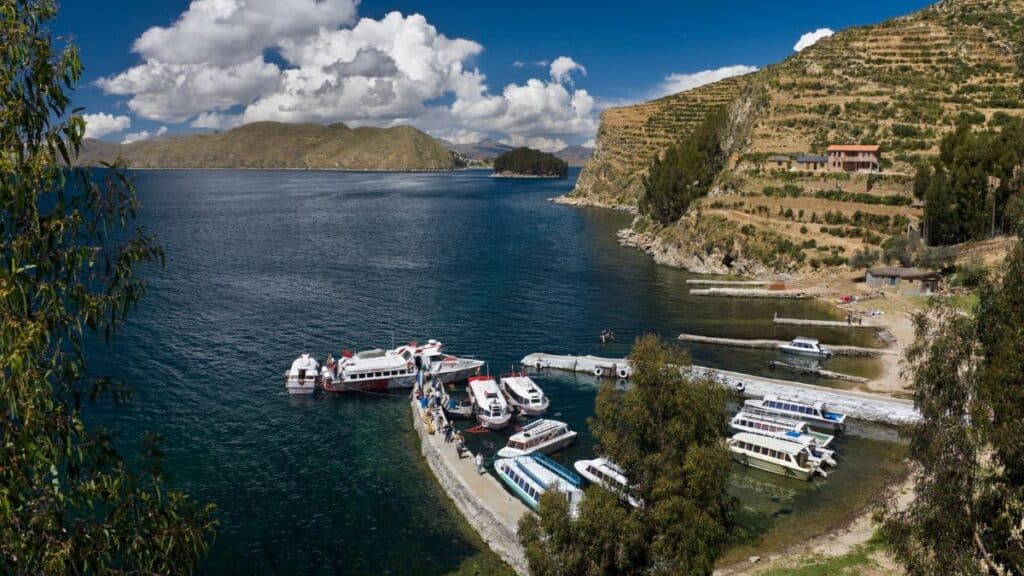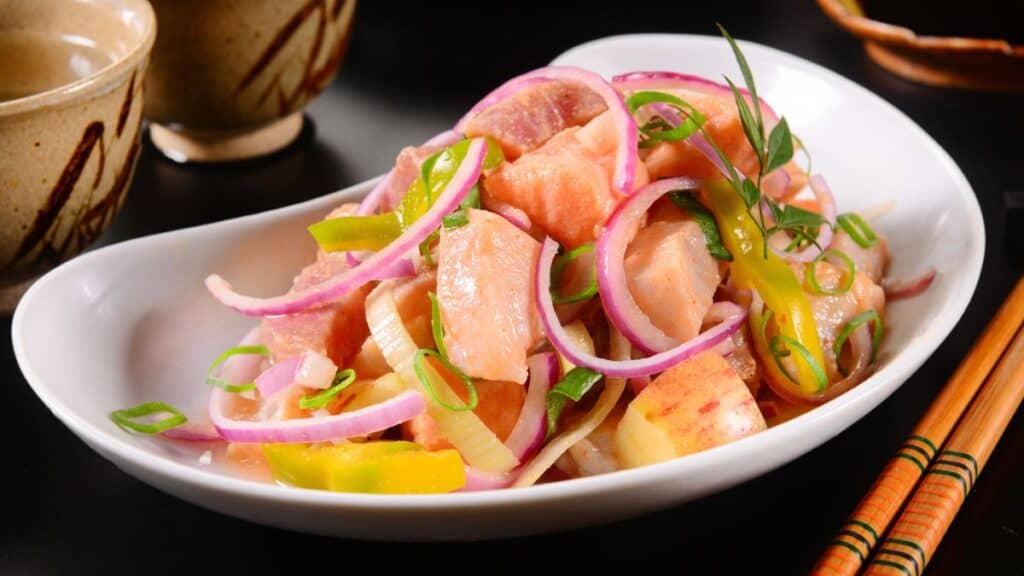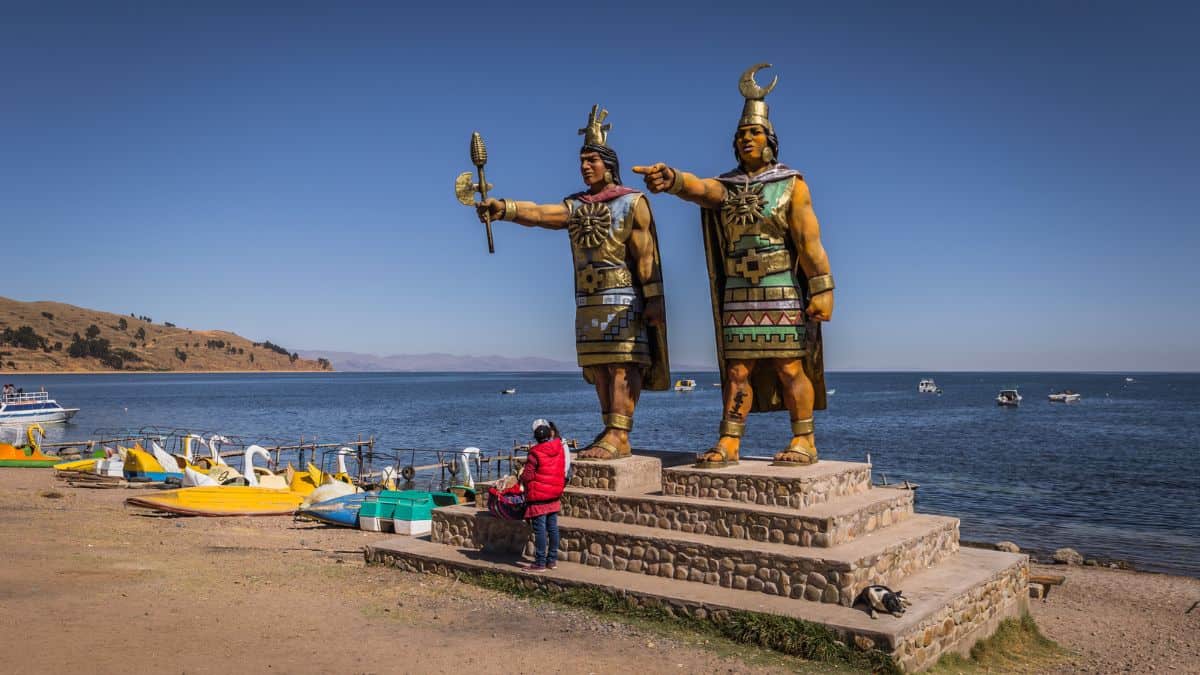Care to add Copacabana to your travel bucket list? Not to that “hottest spot north of Havana” nor the world-famous beach in Rio de Janeiro, but to the tranquil lakeside town of Copacabana Bolivia.
Copacabana, nestled on the shores of Lake Titicaca in Bolivia, boasts stunning lake views and serves as a gateway to mystical destinations like Isla del Sol and Isla de la Luna. With a blend of cultures, traditions, and vibrant festivals, this historical Bolivian city is an ideal spot for a cultural retreat.
Situated at 12,507 feet (3,812 meters) above sea level, Copacabana is the sole public beach in landlocked Bolivia, featuring pebbles instead of sand. The town, flanked by Mount Nino Calvario and Mount Calvario, offers excellent hiking opportunities. At the same time, the expansive Lake Titicaca invites visitors to relax on the beach, embark on boat tours, or explore the waters on various rented watercraft.
Notable for its delectable trout, which can be savored in nearly every local restaurant, Copacabana is not just about food and natural beauty. The city has numerous museums and historical sites that provide insight into Bolivia’s rich history. This overview introduces the lesser-known Copacabana, offering unique attractions that distinguish it from its more famous Rio counterpart and other South American cities.
Best Things To Do in Copacabana, Bolivia – Sights
1. Lake Titicaca
Most of the tourism in Copacabana is due to Lake Titicaca. The magnificent lake is believed to be the birthplace of the sun. As Bolivia has no sea, the lake serves as a substitute. People from all over the world visit to see this magnificent body of water at 12,507 ft (3,812 m).
2. Cerro Calvario Sunset
Cerro Calvario is the hill overlooking the beautiful city of Copacabana. To get the stunning view of the sunset from the top, you must climb up for about 98 ft (30 m) from Calle San Antonio. Cerro Calvario means torturing hill, so don’t expect the hike to be easy.
At that altitude, it will likely take you longer than expected. I was surprised when we spent 30 minutes sweating for a 1.5 km hike. But the view from the top is worth it. On a clear day, you can see very far, and the bay of Copacabana is truly beautiful.
3. Inca Banderani and Kopacati
The Inca Banderani ruins, located near the village of Kopacati, require a two-hour hike to reach. Within the rocks, there are plenty of hidden dark caves. It is advisable to book a guide to assist in locating these caves, as following the village’s signage independently can be challenging.
4. Plaza 2 de Febrero Cathedral

The cathedral at Plaza 2 de Febrero is perfect for learning about Bolivian history. Also recognized as the Basilica of the Virgin of Copacabana, it serves as the sanctuary for Bolivia’s patron saint, the Virgen de Copacabana. Suppose you happen to be in Copacabana on February 2nd or August 5th. In that case, you’ll have the opportunity to partake in the celebrations of the Purification of Mary and the Virgin of Copacabana, respectively.
5. Andean History Museum
The Andean History Museum is located near Plaza Sucre. It is a perfect place to learn about the history of Lake Titicaca. The museum is open from 8:00 a.m. to 6:00 p.m.
6. Car Blessings at Copacabana’s Center
Car blessing is one of the most important practices in Bolivian culture. Local priests bless the cars to provide them with the protection of the patron saint of Bolivia.
The ritual is held in February and attracts pilgrims who get in line for their cars to be blessed and protected. The protection is provided through holy water thrown on each part of the car. Afterward, the owners and their families are treated with the same water to complete the ritual.
7. Del Poncho Museum
Del Poncho is a bright museum on Tito Yupanqui Street. It shows off different types of ponchos, common clothes in Bolivia and other South American countries. You can find the museum on Tito Yupanqui Street.
Best Things To Do in Copacabana, Bolivia – Activities
8. Explore the Nearby Isla Del Sol

A day trip to Isla Del Sol would allow you to explore the magnificent relics of the Inca Empire. Plenty of archeological sites are located within the island, including a large rock that locals believe is where the Inca god named Viracocha created the moon and sun.
9. Isla De La Luna Day Tour
Isla De La Luna (The Island of the Moon) is a small island on Lake Titicaca. Only 100 people live on the island, making it ideal for people who want an even more authentic experience. The main attraction on this small island is the temple of the virgins, where some girls were sacrificed to the sun and moon.
10. Yampupata Hike
The Yampupata hike is approximately 12.4 miles (20 km) from the city center. This day hike offers stunning views of nature and wildlife. You may see animals like llamas and alpacas moving in herds. Although the trail is a bit long, it’s easy to complete, taking about 5 to 6 hours for a one-way journey.
11. Explore the Astronomical Observatory
The astronomical observatory, also known as La Horca del Inca, was first built to study the behavior of the moon and the stars. Nowadays, it provides a stunning view of the sky and Lake Titicaca. The fee to enter the observatory is only 10 Bolivian Bolivianos (1.44 US dollars).
12. Shop at Mercado 2 de Febrero
Mercado 2 de Febrero is located on the streets of Jauregui and Pando. The whole market is divided into three main sections: the vegetables, meats, and fruits section, the breakfast section, and the daily meals section.
At the market, you can discover all kinds of souvenirs, like pottery, fabrics, and jewelry. Plus, there’s tasty local food and drinks.
13. Experience the Aymara Culture
The Aymara community knows Lake Titicaca really well. While you soak in the pretty lake views, you can learn a lot from them. The Aymara folks share stories about how the sun came and how the world began from the lake.
14. Immerse Yourself in Bolivian Nightlife at Avenida 6 de Agosto
Avenida 6 de Agosto is filled with numerous restaurants and bars. The two places that we highly recommend you visit on this street are Akwaaba and Pueblo Viejo. If you want some late-night fun, head to Wiley’s Club on the corner of Busch and Jauregui.
Best Things To Do in Copacabana, Bolivia – Food
15. Try the Delicious Trout

You will never taste a more delicious trout than the one found at Lake Titicaca. The fresh trout is served at stalls on the lake’s shore. The fish can be cooked in 20 different ways, so you will always have something new to try. The basic dish, including trout, chips, salad, and rice, costs around 25 BOB ($4).
16. Sandwiches at El Condor and the Eagle Café
El Condor and The Eagle Café is located at Avenida 6 de Agosto. The restaurant offers delicious breakfasts from 7:00 a.m. to 1:00 p.m. The brunch options include sandwiches made from Irish homemade bread, which is the main highlight of this place. Another highly rated item on the menu is coffee. You can try different flavors, as almost all are delicious.
17. Eat Pizza at Pan America
Pan America restaurant offers the best pizza in town. It is located in the city center near Plaza 2 de Febrero. The pizza crusts are handmade and always served fresh. The toppings are delicious, and the pricing is quite reasonable. The restaurant also offers gluten-free options.
18. Enjoy Seafood Near Lake Titicaca at La Orilla
La Orilla is located on Avenida 6 de Agosto. The restaurant is owned by a small family that serves delicious seafood. The owner’s wife cooks all the meals, whereas the husband serves the food with the son. The seafood is not the only thing to try here, as people love other items, too, such as fajitas and nachos.
19. Ceviche at Restaurant Gourmet ALI

If you’re looking for a good meal on Avenida 6 de Agosto, check out Restaurant Gourmet ALI. You can order almost anything on the menu; the taste and quality won’t disappoint you. But we suggest trying their ceviche—it’s a dish of raw fish soaked in lime and other juices.
20. Visit La Cupula Restaurant
La Cupula is a well-liked dining establishment renowned for its delectable cuisine and tranquil ambiance. Housed within a distinctive lighthouse-inspired structure at Hotel La Cupula, this restaurant presents a menu filled with delightful local dishes, including fresh fish from the nearby lake.
Transportation Options
Copacabana is a famous tourist destination, easily accessible from most major cities in Bolivia.
How to Get There From La Paz
If you are traveling from the capital of Bolivia, La Paz, you can get a bus from the main bus terminal in the morning between 7:00 a.m. and 8:00 a.m. The ticket price depends on the bus service you choose. Bus services such as Titicaca tourist transportation and Vicura travel costs around 48 BOB ($7) for a four-hour journey.
Transportation Modes
There are three ways to get to this town
- By bus
- By private transfer
- By tour
A bus service can also reach this town from nearby countries such as Peru. However, you will have to use an international bus service such as Transzela, which offers a bus ride from Cusco in Peru to Copacabana for only 235 BOB ($34).
Getting Around Copacabana
The best way of getting around in Copacabana is by taxi. It is such a small town that you can also move from one place to another on foot. Undoubtedly, a walking tour of this city offers the best experience of its architectural and natural beauty.
Where To Stay In Copacabana Bolivia
Copacabana is a small city, so the accommodation options are pretty limited. However, the quality of service provided by the available hotels is exceptionally good. The best area to stay in this city is its center. You will find plenty of hotels and hostels in this area. The best ones include:
- Hostal Piedra Andina (Budget): A budget hostel located only half a mile from the center of Copacabana is perfect for a long stay. The hostel offers a green garden and lake view with every room available. Moreover, nearby activities such as Copacabana Cathedral and the main market make the stay even more convenient.
- Hostal Las Olas (Mid-range): Hostal Las Olas is another great place near the Copacabana market. Every room offers a lake view and a seating area to relax. Some of the most popular attractions near the hotel include Inca Gallows, Copacabana Stadium, and The Cavalry.
- Hotel Rosario Lago Titicaca (Luxury): For a luxurious experience, there is no better place than Hotel Rosario Lago Titicaca. The colonial architecture and views of Lake Titicaca are the main highlights of the hotel. It is so close to the lake that you can even walk to reach it.
For more accommodation options, you may click on the map.
Tips To Stay Safe During Your Copacabana Bolivia Visit
Here are eight expert tips that you can follow to make your Copacabana trip memorable:
- Copacabana is at a height of 12,507 ft (3,812 m), so it’s important to acclimatize yourself before arriving.
- During the first couple of days at Copacabana, drink plenty of water and eat lightly to avoid the negative effects of high altitude.
- Although Copacabana is quite safe to walk during the daytime, it is not the case once the sun goes down. Make sure you walk in crowds or avoid going out at night.
- Stray dogs can become a threat while hiking, so bring some rocks and sticks for your protection.
- Copacabana can be quite cold, even on a sunny day, so pack some fleece jackets.
- Hiking boots and trousers are a must while visiting hilly areas. Sunscreen and lip balm are also recommended.
- The best time to visit Copacabana is between May and October, which is the dry season.
- The wet (rainy) season lasts from November to April. If you visit during that time, bring a rain jacket or umbrella.
- Additionally, consider protecting yourself with travel insurance such as SafetyWing, which can cover medical emergencies, trip cancellations, and other unforeseen incidents during your stay. Use the widget below to snag the perfect policy for your needs and travel with peace of mind knowing you’ve got your back covered, no matter what adventures come your way!
Frequently Asked Questions (FAQs) – Copacabana Bolivia
Is Copacabana in Peru? What Region Is Copacabana In?
Copacabana is a small town on the Bolivian side of Lake Titicaca. It is also a border crossing point between Bolivia and Peru. It is located in the Manco Kapac province, part of Bolivia’s La Paz department.
What Is Copacabana Bolivia Known For?
Copacabana, Bolivia, is known for its breathtaking views of Lake Titicaca. The town is located between two hills overlooking the magnificent lake in front. The city offers some of the best seafood and hiking activities in Bolivia.
Is Copacabana Bolivia Worth Visiting?
Copacabana is worth visiting for those looking for adventurous hikes and mesmerizing views. It can also be used as a base to enjoy the amazing Isla del Sol and Isla de la Luna. A boat ride on the sparkling blue waters of the lake alone is enough to convince tourists to visit this heaven on Earth.
Conclusion – Copacabana Bolivia
If you enjoy tranquil beaches, mesmerizing waterscapes, and nature hikes, as well as exploring a new place’s rich cultural heritage, Copacabana Bolivia is the next stop for you.
We hope the information above will help you make smart choices suited to your time, budget, and interests. May you have a relaxing, fun, and memorable trip to this enchanting destination.
Your Ultimate Travel Guide & Booking Resources
Skyscanner is my trusted ally for booking flights, guiding me to the perfect travel options while making the journey planning process a breeze with its user-friendly interface and extensive search capabilities.
12Go Asia is my ultimate travel companion in Asia, offering the best budget service platform for seamless booking of trains, buses, ferries, and flights, ensuring every adventure unfolds smoothly and effortlessly.
Booking.com is my ultimate lodging partner. It offers many accommodations worldwide and simplifies my travel experiences with its user-friendly platform and unbeatable deals.
Get Your Guide is my go-to for personalized travel experiences, enriching my journeys with unique tours and activities curated to my interests, making every adventure unforgettable and tailored to my preferences.
SafetyWing is my peace of mind on the go, offering comprehensive travel medical insurance with affordable plans and hassle-free claims, ensuring I can explore the world worry-free, knowing I’m protected wherever I roam.
LifeStraw Go Bottle is my trusted hydration companion for outdoor adventures, filtering water on-the-go to keep me safe and hydrated, ensuring every hike or travel experience is worry-free and enjoyable.
Related Reads:
- 3 Amazing Tours To Experience Salar de Uyuni and Bolivia Salt Flats
- Navigating the Safest Cities in South America
Founder of Spark Nomad, Radical FIRE, Copywriter
Expertise: Personal finance and travel content. I’m a full-time traveler, and I’ve been to 49 countries and 5 continents.
Education: Bachelor of Economics at Radboud University, Master in Finance at Radboud University, Minor in Economics at Chapman University.
Over 200 articles, essays, and short stories published across the web.
Marjolein Dilven is a journalist and founder of Spark Nomad, a travel platform, and Radical FIRE, a personal finance platform. Marjolein has a finance and economics background with a master’s in Finance. She has quit her job to travel the world, documenting her travels on Spark Nomad to help people plan their travels. Marjolein Dilven has written for publications like MSN, Associated Press, CNBC, Town News syndicate, and more.

